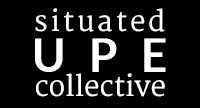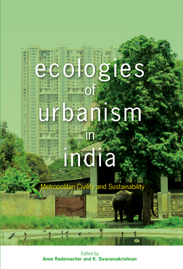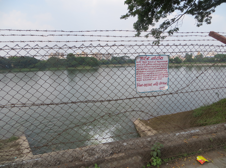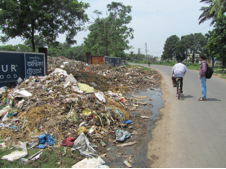Anna Zimmer gives a reflection on a recent workshop organised by Anne Rademacher & K. Sivaramakrishnan at the Hong Kong Institute for Humanities and Social Science, 9-12 June 2014.
Last week, I participated in the stimulating workshop on Ecologies of Urbanism with the subtitle ‘Cities, towns, and the places of nature’ organised by Anne Rademacher & K. Sivaramakrishnan in Hong Kong, who recently also published an edited book with the title Ecologies of Urbanism in India.
Now, back at my desk here in Delhi, I use the SUPE Commentary platform to reflect on this exchange from the perspective of the aim of creating a more Situated Urban Political Ecology. This reflection is necessarily partial and personal and does not do justice to the workshop as a whole but is intended as a way to share my current thought processes.
Entanglements of nature and identities
One convergence of the many papers centred on the entanglement of social identities and urban nature. This was expressed in a row of presentations, including the cultivation of the self in urban parks to express resistance to the secularisation of urban spaces in China (presented by Anna Greenspan and Francesca Tarrocco); the iconic role of large mammals in creating specific city identities (Frédéric Landy); the devotion to different deities through the protection of forested hills in Jahazpur, India (Ann Gold); the intent to produce socialist and urban citizens through visible water infrastructure in Vinh city, Vietnam (Christine Schwenkel); the distinction between different informal citizenship statuses through water infrastructure in Manila (Deborah Cheng); and the differentiation between class A and class B immigrants in the abysmal housing conditions in Rangoon (Rajashree Mazumder). But also how the Birla’s, a business family in India, build simulacra of nature in the form of concrete caves or parks to improve their social standing and widening their social networks (Kajri Jain), and my own contribution on how reputation can be built through ‘giving one’s name’ to urban parks through public-private partnerships in Navsari, India.
All these varied processes demonstrate how urban nature is an integral part of the ways urban dwellers build identities, express subjectivities, create reputation, and resist ascriptions or prescriptions regarding interaction with nature. While the question of identities might be only one of the various layers that motivate certain projects, as Kajri Jain reminded us in the discussion, it is a powerful one that has only just started receiving attention in UPE (but see, Truelove 2011; and Ernstson 2013).
Fundamentally, and as demonstrated by the presentations, these nature-identity entanglements rest on day-to-day practices such as practicing wushu, patrolling urban forests, and washing clothes at a public fountain. This confirms the fruitfulness of using everyday dimension of interaction with, and production of urban ecologies, one theme the SUPE Collective equally pursues.
At the same time, the discussions in Hong Kong focussed on the way political projects are inscribed in urban nature. We heard about socialism in Vietnam and China; urban restructuring along class lines in India; colonialism in Hong Kong; and immigration control in Burma. This inscription is not free of contradictions. One example was the contradictory role of the subway/metro as a means of urban transport. In Calcutta in the 1980s it symbolized socialist progress, while in Delhi in early 2000 it was showcased as marker of neoliberal growth.
Often such political projects are expressed through specific aesthetics, and we discussed aesthetics of ‘wilderness’ in colonial Hong Kong, the monumentality of certain environmental projects like fountains, or animal sculptures, as well as current ‘beautification’ drives in India (the timeliness of which was confirmed on my arrival back home in Delhi with the newspaper headline on the 18th of June stating that Delhi was “the first stop for beautification exercise” of the new Modi government. This prompts obvious but important questions: Which nature is showcased? Which aesthetics are realised in planning and architecture? These questions have been addressed in Urban Political Ecology studies of Norther cities (see for instance Quastel 2009; Hagerman 2007; Gandy 2003), but have not been tackled sufficiently in non-Western cultural and social contexts so far.
Connections across space and time
One powerful picture that emerged in the discussions was presented by Rajashree Mazumder as the ’72 hours’—the revolutionary short time the steam ship needed to connect Calcutta and Rangoon in the 1860s. The steamship as such became a metaphor for something essential within the workshop: a powerful reminder of the connectedness of urban ecologies to “multiple elsewheres” (Mbembe and Nuttall 2004)—and, one might add, “multiple elsewhens”. It served as a reminder of how historical and contemporary layers of urban ecologies are all connected to other places through practices, circulating knowledge and people, material ‘stuff’, inspirational ideas, and even spiritual links. And how these endless layers of relations complicate, and enrich, our reading of the current moment and specific cities. (One might also argue, that so do future layers when future plans for places shape the present moment).
Nature/culture and challenges of ontology
As might be expected, the discussion also touched upon the topic of the nature/culture dichotomy, with Robert Peckham’s paper on the co-creation of large plantations with the expansion of Hong Kong to improve water availability; Frédéric Landy’s paper on transgressions of leopards from an urban national park into Mumbai; and the mentioning of the model of Uttar Pradesh in India as an “agropolis”. All these contributions questioned the necessity or helpfulness of the terms urban, rural, and nature. Ontologically the most challenging piece was the one by Anna Greenspan and Francesca Tarrocco, exhibiting the Chinese notion of ‘cultivation’, which extends across the human body to nature. Daoist paintings that depict the human body as a landscape, criss-crossed by rivers and cultivated by ploughs, expressed the irrelevance of the boundary between humans and their surroundings. To me, this chimed with my reading at the same time of Sarandha Jain’s book In search of Yamuna. Reflections on a River Lost (2011, Vitasta Publishing). Here, she mentions the Indian philosophical approach of ‘advaita’ or one-ness (literally: non-twoness). Advaita holds (to say it shortly, and with risk of being extremely simplistic) that the self/atman and the supreme reality behind the material world/brahman are one and the same. This notion of one-ness contrasts with the Hindi term ‘pariyavaran’ or environment that, as Ann Gold reminded us entered the discourse at least in Jahazpur first through the school textbooks in the 1990s. How such a perception of one-ness can forward our thinking on urban political ecologies, for example when investigating how nature is perceived and valued or how nature enters processes of identity-building and shapes subjectivities, remains however to be elaborated.
Labour and practice
One topic we missed out almost completely in the workshop (as noticed by Christina Schwenkel in the discussion) was the voices of those who actually build urban nature. Exploring the different forms of labour as a means of engaging with urban nature directly, and the theoretical insights and forms of knowledge that such labour generates could and should be an integral part of UPE inquiries and yield important new perspectives (as e.g. Alex Loftus (2007) showed in the Southern African context).
However, Himanshu Burte’s paper on Bhuj (India) offered the much-required link towards political practice and echoed the concern of SUPE to offer alternative means of engaging and altering urban political ecologies. His distinction between ‘experts in residence’ and ‘airborne experts’ resonates with the importance of place or groundedness for theory making as well as urban practice that is of concern in the project of provincialising UPE (see Henrik Ernstson’s and Anthony Levenda’s reflections in this commentary section).
In our discussion afterwards that I had with Himanshu in the plane journey home, we touched upon his idea of craft values (elaborated on in his book from 2008, Space for Engagement. The Indian Artplace and a Habitational Approach to Architecture, Seagull Books). This idea expresses the concern that even the best-intentioned interventions will necessarily have unwanted outcomes if the way we implement them is not anchored in the same human values that drive these interventions in the first place. The alliance of NGOs active in the “Homes in the City” project in Bhuj relies for example on consensus building for taking decisions. This stands in contrast to majority democratic procedures of casting votes, which would risk to disrespect desires and aspirations of minorities.
Consensus building,recognized as a difficult, arduous but in this project, a worth-while political process, can act as a stage for negotiation (and it does not refer to post-political consensus, as critiqued by Erik Swyngedouw, 2009). This, in turn, influences urban ecologies directly as well as indirectly, as all involved actors change slowly and gradually through the process of ongoing engagement with each other. Although recognizing that I am perhaps overly optimistic here, the process of growing mutual respect can furthermore lead to the empowerment of marginalised actors. Such a consensus-orientation in practice contrasts with theory-building that rests first and foremost on the conceptualisation of the politicised urban environment as a conflict ridden arena for struggle. How this tension can be fruitfully maintained is something we have not been able to address yet. It speaks however to Mary Lawhon, Henrik Ernstson and Jonathan Silver’s ((2013)) argument that radical incrementalism has to be considered a serious option for ways forward.
References
Ernstson, Henrik. 2013. Re-Translating Nature in Post- Apartheid Cape Town: The Material Semiotics of People and Plants at Bottom Road. Vol. 4. Actor-Network Theory for Development Working Paper Series. Manchester: Centre for Development Informatice. http://www.cdi.manchester.ac.uk/resources/ant4d.
Gandy, Matthew. 2003. Concrete and Clay: Reworking Nature in New York City. Cambridge, MA & London: MIT Press.
Hagerman, Chris. 2007. “Shaping Neighborhoods and Nature: Urban Political Ecologies of Urban Waterfront Transformations in Portland, Oregon.” Cities 24 (4): 285–97. doi:10.1016/j.cities.2006.12.003.
Lawhon, Mary, Henry Ernstson, and Jonathan Silver. 2013. “Provincializing Urban Political Ecology: Towards a Situated UPE through African Urbanism.” Antipode 46 (2): 497–516. doi:10.1111/anti.12051.
Loftus, Alex. 2007. “Working the Socio-Natural Relations of the Urban Waterscape in South Africa.” International Journal of Urban and Regional Research 31 (1): 41–59.
Mbembe, Achille, and Sarah Nuttall. 2004. “Writing the World from an African Metropolis.” Public Culture 16 (3): 347–72. doi:10.1215/08992363-16-3-347.
Quastel, Noah. 2009. “Political Ecologies of Gentrification.” Urban Geography 30 (7): 694–725. doi:10.2747/0272-3638.30.7.694.
Swyngedouw, Erik. 2009. “The Antinomies of the Postpolitical City: In Search of a Democratic Politics of Environmental Production.” International Journal of Urban and Regional Research 33 (3): 601–20. doi:10.1111/j.1468-2427.2009.00859.x.
Truelove, Yaffa. 2011. “(Re-) Conceptualizing Water Inequality in Delhi, India through a Feminist Political Ecology Framework.” Geoforum 42 (2): 143–52.



